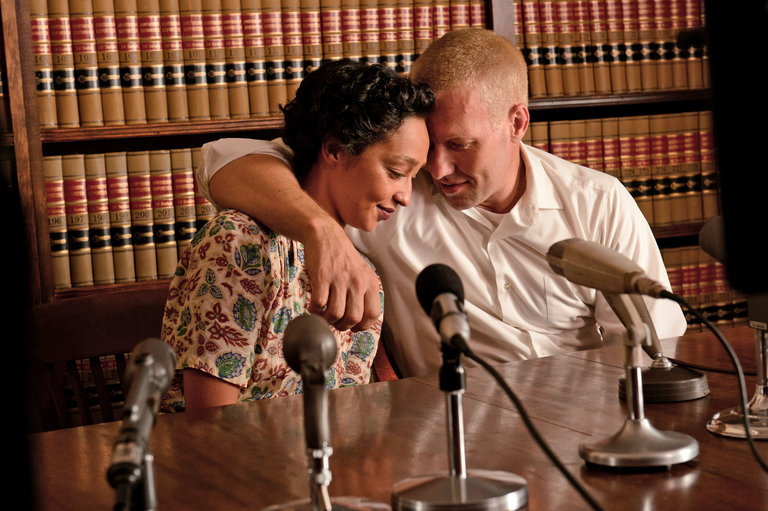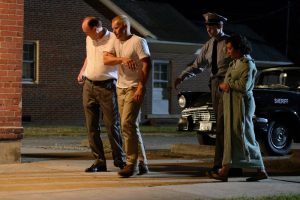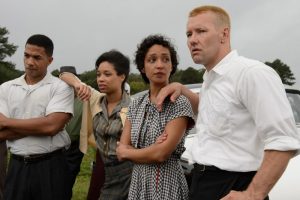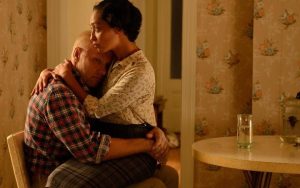 Title: Loving | Rated: PG-13 | Runtime: 123 min | Theaters limited (expanding)
Title: Loving | Rated: PG-13 | Runtime: 123 min | Theaters limited (expanding)
With the Supreme Court’s ruling on Obergefell v. Hodges last year and as the fight for the recognition of same-sex marriage continues, the story of Mildred and Richard Loving feels very relevant – especially how their experiences culminated in the 1967 Supreme Court ruling on Loving v. Virginia, which invalidated laws prohibiting interracial marriage. How timely, then, that their story has now been realized on the big screen by filmmaker Jeff Nichols. With the resulting film Loving, Nichols strips down this incredible journey to its basic human elements and focuses on the two people who started it all, thus honoring their humanity, legacy, and love.
 Nichols adopts a rather nonconformist approach in telling the Lovings’ story, and it pays off handsomely. Indeed, one can easily imagine their tale being told as a courtroom drama featuring plenty of hand-wringing and shouting matches, but that’s certainly not what the writer-director is interested in. Nichols recognizes that Loving v. Virginia began with a black woman and a white man who married and wanted to live in peace but were treated as criminals by their state, which outlawed interracial marriage. By centering on them and their predominantly quiet lives, he largely avoids portraying the court processes, but does invite the audience to empathize with the Lovings and truly get to know them as human beings. It’s not just their relationship that’s under the microscope; the film goes great lengths to show what Mildred (Ruth Negga) and Richard (Joel Edgerton) are like as individuals and how they differ from each other. Richard is a man who values his privacy and, given their situation, struggles to meet society’s fundamental value in masculinity: the ability to take care of his family. Mildred’s interest in publicly pursuing justice highlights the fact that she is black and a woman, both of whom are looked down upon during this period. Nichols develops the Lovings so richly and tenderly, and we invest in them so deeply that when the film at times assumes their lawyers’ perspectives, it feels foreign and jarring.
Nichols adopts a rather nonconformist approach in telling the Lovings’ story, and it pays off handsomely. Indeed, one can easily imagine their tale being told as a courtroom drama featuring plenty of hand-wringing and shouting matches, but that’s certainly not what the writer-director is interested in. Nichols recognizes that Loving v. Virginia began with a black woman and a white man who married and wanted to live in peace but were treated as criminals by their state, which outlawed interracial marriage. By centering on them and their predominantly quiet lives, he largely avoids portraying the court processes, but does invite the audience to empathize with the Lovings and truly get to know them as human beings. It’s not just their relationship that’s under the microscope; the film goes great lengths to show what Mildred (Ruth Negga) and Richard (Joel Edgerton) are like as individuals and how they differ from each other. Richard is a man who values his privacy and, given their situation, struggles to meet society’s fundamental value in masculinity: the ability to take care of his family. Mildred’s interest in publicly pursuing justice highlights the fact that she is black and a woman, both of whom are looked down upon during this period. Nichols develops the Lovings so richly and tenderly, and we invest in them so deeply that when the film at times assumes their lawyers’ perspectives, it feels foreign and jarring.
 The character-centric story gives Edgerton and Negga plenty of room to bring the Lovings to life, and they do so with marvelous sensitivity. Though one can certainly sense a restraint in their performances, it’s integral in making the characters believable. There’s a vulnerability to Richard that Edgerton imparts through his seemingly submissive demeanor and hunched over-like posture. Though he didn’t ask for it by any means, the weight of the world is on his shoulders, and the quiet Edgerton needs no words to communciate that. Though decidedly more outspoken than her husband, Mildred too is generally a quiet person, and more often than not, Negga’s charming, gentle performance rests on her large eyes, expressing fear, heartbreak, hope, and joy. The relationship between these two leads is appropriately subdued yet full of emotional honesty, manifesting mostly in intimate touch. A mostly reliable and solid supporting cast backs them, though there are a few exceptions; Nick Kroll is arguably miscast as ACLU lawyer Bernard Cohen, and while Marton Csokas is fine as Sheriff Brooks, his articulation renders his dialogue to be rather unintelligible.
The character-centric story gives Edgerton and Negga plenty of room to bring the Lovings to life, and they do so with marvelous sensitivity. Though one can certainly sense a restraint in their performances, it’s integral in making the characters believable. There’s a vulnerability to Richard that Edgerton imparts through his seemingly submissive demeanor and hunched over-like posture. Though he didn’t ask for it by any means, the weight of the world is on his shoulders, and the quiet Edgerton needs no words to communciate that. Though decidedly more outspoken than her husband, Mildred too is generally a quiet person, and more often than not, Negga’s charming, gentle performance rests on her large eyes, expressing fear, heartbreak, hope, and joy. The relationship between these two leads is appropriately subdued yet full of emotional honesty, manifesting mostly in intimate touch. A mostly reliable and solid supporting cast backs them, though there are a few exceptions; Nick Kroll is arguably miscast as ACLU lawyer Bernard Cohen, and while Marton Csokas is fine as Sheriff Brooks, his articulation renders his dialogue to be rather unintelligible.
 It’s impressive how under Nichols’ direction, the film reflects the Lovings’ sensibilities from the top down. Cinematographer Adam Stone is never flashy with his images and camera movements, instead preferring to get the point of the scene across in simple still frames. Production designer Chad Keith balances the “lived in” feel and workaday look of the Lovings’ homes with the mild beauty of the Virginian outdoors, making it clear why the Lovings want to raise their family in Virginia as opposed to any other state. The costumes, designed by Erin Benach, not only suit the period well, but also never stick out and boast the same “lived in” feel as the homes do. David Wingo’s soft score never overwhelms, but sometimes does swell ever so carefully to audibly illustrate the characters’ waves of emotions.
It’s impressive how under Nichols’ direction, the film reflects the Lovings’ sensibilities from the top down. Cinematographer Adam Stone is never flashy with his images and camera movements, instead preferring to get the point of the scene across in simple still frames. Production designer Chad Keith balances the “lived in” feel and workaday look of the Lovings’ homes with the mild beauty of the Virginian outdoors, making it clear why the Lovings want to raise their family in Virginia as opposed to any other state. The costumes, designed by Erin Benach, not only suit the period well, but also never stick out and boast the same “lived in” feel as the homes do. David Wingo’s soft score never overwhelms, but sometimes does swell ever so carefully to audibly illustrate the characters’ waves of emotions.
In making the story of Loving v. Virginia all about the Lovings themselves, Loving gets us to invest in them so intensely and root for their love to prevail, which goes to show that love is love is love is love is love is love is love is love. What better to celebrate the Lovings and their victory than to intimately know them as human beings and push forward in our own lives with that empathy?
Rating: 4.0/5.0
* Photos courtesy of Focus Features
